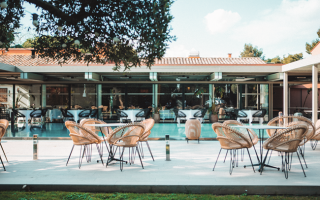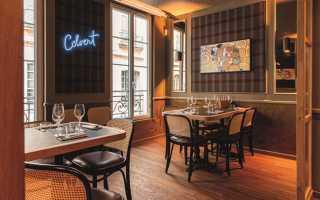Meandering in Montmartre
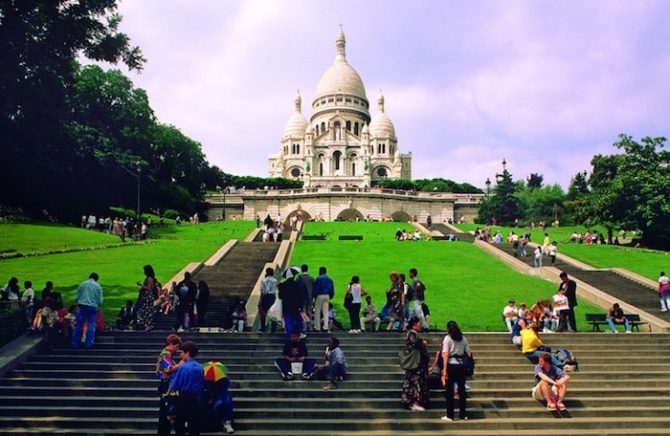
Montmartre scarcely needs an introduction. Enthroned above Paris, the Basilica of Sacré Coeur is as much a part of the city’s skyline as the Eiffel Tower and surpasses it in terms of visitors. What with the Moulin Rouge and Toulouse-Lautrec, the Moulin de la Galette and Renoir, Au Lapin Agile, the Bateau Lavoir, the paintings of Van Gogh, Utrillo and Toulouse-Lautrec, and more recently the fabulous world of Amélie Poulain—Montmartre embodies the mystique of Paris, a fact well exploited by the film and tourist industries over the years.
Yet, except for the vicinity of Sacré Coeur and the Place du Tertre, Montmartre remains a bucolic haven, at once quintessentially Parisian and a world set apart. It is also the depository of major, often disparate, pages of Parisian and world history, haphazardly and astonishingly intertwined on this tiny hilltop, familiarly known as La Butte.
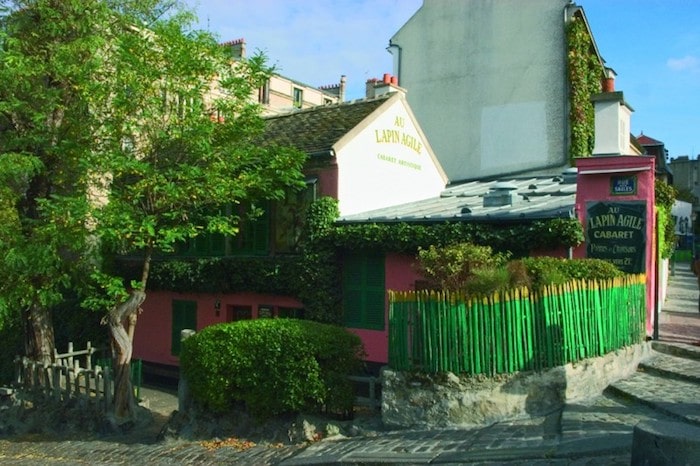
The Lapin Agile. Credit © Paris Tourist Office/Amélie Dupont
Set aside an early blue morning for your walk and start off from Place des Abbesses, the gathering place of Montmartre’s current bobo (bourgeois bohemian) residents. The Abbesses Métro station is now known for one of Hector Guimard’s few remaining Art Nouveau entrances, this one actually moved here from the Hôtel de Ville only in 1974. Standing south of the square, Saint Jean de Montmartre, inaugurated in 1904, was the city’s first church made of reinforced concrete. But the concrete was hidden behind brick, hence its nickname, Saint Jean des Briques.
The abbesses in question—46 in all—were those of the Benedictine Abbey of Montmartre, founded in 1133 by Queen Adélaïde de Savoie on top of the hill; among them were 17-year-old Claude de Beauvilliers, who ended up in the arms of Henri de Navarre, the future King Henri IV, and the last abbess, 71-year-old Marie-Louise de Montmorency-Laval, who ended up on the guillotine.
In the 17th century the abbey moved to the lower and more convenient location of rue Yvonne Le Tac, east of the square, where the crypt of its chapel, at No. 11, called the Martyrium, is said to mark the site of the martyrdom of Saint Denis in about 250 AD—hence one possible source for the name Montmartre, from Mont des Martyrs. (From here the holy man allegedly set off north, carrying his decapitated head over the hill to the site of the future Abbey of Saint Denis, in what is now the suburb of the same name, where he finally collapsed.)
The hilltop crypt became a pilgrim destination visited by, among others, Ignatius of Loyola, who made it the birthplace of the Jesuit order in 1534. The street’s namesake Yvonne Le Tac comes from a different page of history: the head teacher of the school next door, she was a member of the Resistance during World War II.
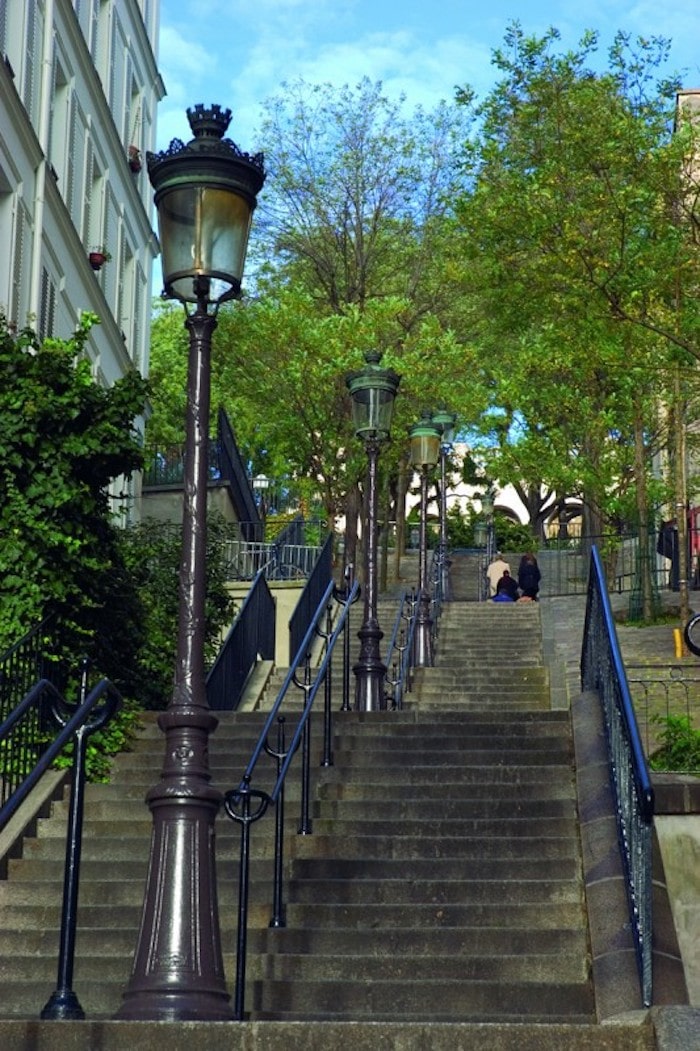
One of the many staircase streets in Montmartre. Credit: © Paris Tourist Office/Amélie Dupont
Les poulbots
North of Place des Abbesses, on the shady little Place Emile Goudeau, stood the legendary Bateau Lavoir (the wash-house), a wretched wooden structure housing penniless artists, where the Fauve and Cubist revolutions gestated at the dawn of the 20th century. The birthplace of Picasso’s Les Demoiselles d’Avignon (1907), it went up in flames in 1970 and the building now standing here is but a pale shadow of the original.
A little farther up, the pretty Place Jean-Baptiste Clément is named after the Mayor of Montmartre during the 1871 civil war of the Commune, who also composed the famous love song Le Temps des Cerises (The Time of the Cherries)—sung by Charles Trenet, Yves Montand and the rock group Noir Désir among many others—which the Commune adopted as its hymn.
Continue uphill through rue Gabrielle, where a plaque at No. 49 indicates Picasso’s first independent studio. Rue du Calvaire, on your left, is in effect a steep flight of steps—as many small streets in Montmartre turn out to be. The reward at the top is a breathtaking view of Paris from the tiny, leafy Place Poulbot, named after the cherished illustrator and poster artist Francisque Poulbot, who devoted his life to drawing, and caring for, Montmartre’s street urchins—such kids were for decades afterwards referred to as poulbots. He even built a free clinic for them in the backyard of A La Pomponnette, a genuine old-time restaurant, which has unfortunately now closed its doors on rue Lepic.
The Dalí museum, Espace Dalí, stands at No. 11 rue Poulbot. Things get increasingly touristy and crowded as you approach the Place du Tertre. This was already the case back in the 1920s when Montmartre’s eccentric “Commune Libre” organized local elections with a proposal to introduce a regulation limiting the number of people allowed in the square to 100,000! In 1898, Louis Renault, having driven up the hill in his newly invented car, made the Place du Tertre a landmark for the French automobile industry. One legend has it that the Place du Tertre is also the birthplace of the word bistrot, derived from the Russian word for “quickly”, going back to 1814, when the occupying Cossacks used it to urge waiters in the restaurant La Mère Catherine, at No. 6, to hurry with their orders. That legend is disputed, however, and there are several other theories about the word’s origin.
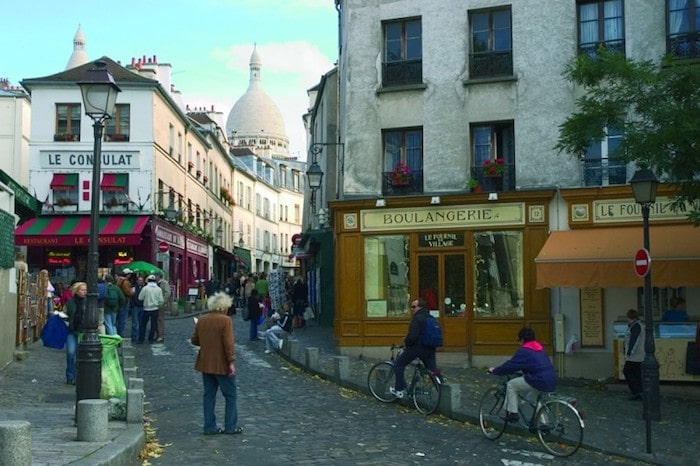
Rue Norvins. Credit © Paris Tourist Office/Amélie Dupont
Saint Pierre de Montmartre, just off the Place du Tertre, on the rue du Mont Cenis, is the oldest surviving church in Paris (1147) and the only vestige of the former abbey. At 423 feet, it stands on the city’s highest spot, which is why Claude Chappe installed here his first telegraphic semaphore, in 1794. A century later it took all the determination of the local residents to save the church from demolition. Inside are four Roman pillars, which were probably recovered from the earlier temples of Mercury and Mars that once stood on the spot. (Another possible source for the name Montmartre, from Mons Martis.) The tombs of Adélaïde de Savoie and Marie-Louise de Montmorency-Laval are in the church, and its cemetery contains the tombs of the explorer Louis-Antoine de Bougainville and some of the Debrays, Montmartre’s famous millers and owners of the Moulin de la Galette.
Rue du Chevalier de la Barre, north of the church, was still rue des Rosiers on March 18th, 1871, when the Communards executed two generals in the backyard of No. 36—the first bloody incident of the Commune uprising. In retaliation, Louis-Eugène Varlin, a supporter of the Commune was sentenced to death here by a court martial after the defeat of the Commune and immediately shot, standing against the wall on the corner of rue de la Bonne. But then, the Communards had executed the Archbishop of Paris…. It was in this context of political violence that the project of Sacré Coeur was conceived, initially to bring about religious and national renewal, in effect “to expiate the crimes of the Communards” as stipulated in the National Assembly’s decree of 24 July 1873.
Big bell
The 19-year-old Chevalier de la Barre had been tortured, beheaded, then thrown into a fire in 1766 for failing to uncover his head before a religious procession and other petty instances of “blasphemy”. The renaming of the street after him, a century later, by the local municipality was a way of counteracting the grandiose Sacré Coeur project. A statue of the young rebel stands in the Square Nadar on rue Azaïs, as you head south towards the front of the Basilica.
Designed by the architect Paul Abadie and built between 1875 and 1919, the colossal dimensions of the Basilica, its position atop the hill and the choice of white stone are all to be understood within the political and moral context. In contrast to the Baroque style of the contemporary and decadent Opera House designed by Charles Garnier, the controversial Romano-Byzantine style of Sacré Coeur was a call for a return to Christian roots, as was the Christ in Majesty in the apse, naturally said to be the world’s largest mosaic. The Basilica’s mighty 19-ton bell, cast in Annecy and known as La Savoyarde, is one of the world’s largest, housed in a 275-foot tower which the local community disparaged as the “minaret”, an uncanny designation in light of the current French and European context. Needless to say, the view overlooking Paris from Sacré Coeur is breathtaking.
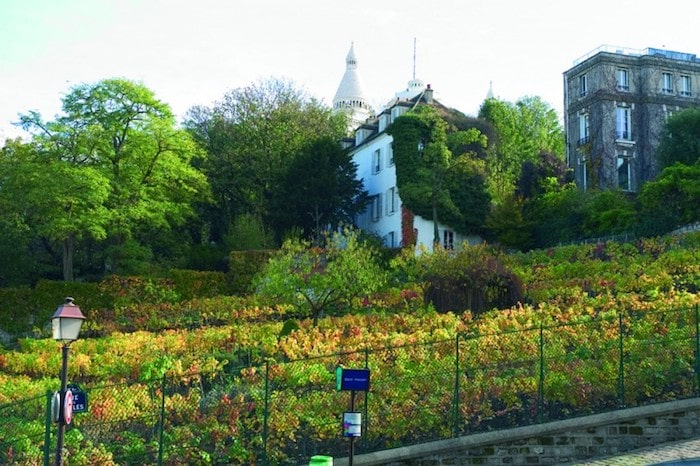
The Montmartre vineyard on rue des Saules. Credit © Paris Tourist Office/Amélie Dupont.
The rue du Mont Cenis allegedly follows the route taken by Saint Denis as he carried his head north. Every seven years a procession marched along this route from the Basilica of Saint Denis to the church of Montmartre, a tradition maintained for a thousand years until the Revolution ended it in 1789.
At 12 rue Cortot is the Museum of Montmartre, still surrounded by the garden where Auguste Renoir painted his famous Swing. Several artists had studios in this building, including Renoir, Suzanne Valadon and her son Maurice Utrillo. The museum, a delightful old slice of Montmartre with its charming memorablia preserved in situ, was renovated in 2014.
Farther on, along rue des Saules to the right is Montmartre’s small, celebrated vineyard. Its autumn harvests, usually on the first Saturday of October, are accompanied by music and colorful processions of winemakers from all over France and as far beyond as Japan. The wine is pressed in the cellar of the Mairie (the 18th arrondissement City Hall), the bottle labels are painted by local artists, and the money raised from its sale goes to charity.
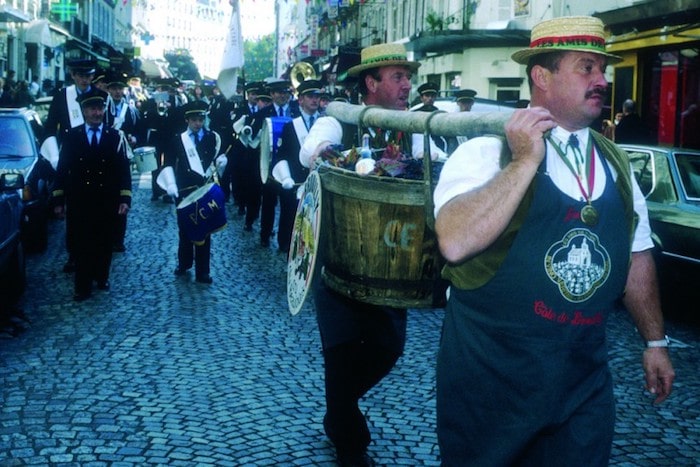
Celebrating the Montmartre grape harvest. Credit © Paris Tourist Office/Amélie Dupont
Frédé and Lolo
Facing the vineyard on the corner of rue Saint Vincent is the bright pink cottage of the tiny cabaret Au Lapin Agile, so called after artist and caricaturist André Gill’s shop sign of a rabbit jumping out of a saucepan, now on display at the Museum of Montmartre. (As well as an agile rabbit, it’s a lapin A. Gill, or là peint A. Gill—there paints A. Gill.)
In its early 20th century heyday, the place belonged to Aristide Bruant, who leased it to Frédé, a fishmonger who used his donkey Lolo to carry fish from Les Halles. When Frédé turned innkeeper, Lolo became the mascot of the cabaret, and also a painter on one memorable occasion, when paintbrushes were tied to his tail and a canvas placed underneath. The resulting masterpiece was entered, and accepted (!), for the 1910 Salon des Indépendants under the title Sunset Over the Adriatic. In 1955 it was exhibited again at the Grand Palais, this time as part of an exhibit about fake art.
Frédé graced his customers nightly with his approximative singing and scraping on his untuned guitar. He was a generous host and offered his impoverished artists a two-franc menu—still too expensive for many. But, not wanting trouble with the police, he did not hesitate to kick out Utrillo and Modigliani when they were drunk. Despite its picture-postcard look, Au Lapin Agile is no tourist trap. It’s not cheap, but it still offers songs and humor in the spirit of old Montmartre and is one of the last places where the cabaret tradition of vieux Paris is preserved.
Retrace your steps on rue des Saules and turn right into rue de l’Abreuvoir, which led to the village water trough. Beyond it the Allée des Brouillards is a serene oasis, once the home of Renoir and family. To the left, Square Suzanne Buisson offers a statue of Saint Denis holding his head. Just south of the square, Place Marcel Aymée is the junction of several well-known Montmartre arteries, notably Avenue Junot, Montmartre’s most elegant street, and the rue Lepic, which winds its way downhill to the Moulin Rouge on Boulevard de Clichy.
At No. 83 rue Lepic stands one of Montmartre’s two surviving windmills, Le Moulin du Radet, which has been converted into a restaurant and misleadingly named Le Moulin de la Galette. The otherwise more famous windmill is situated just beyond and is best viewed from rue Tholozé on your left. The restaurant remains a great place for winding down at the end of your walk, especially in its lovely hidden garden in the back.
From the France Today archives
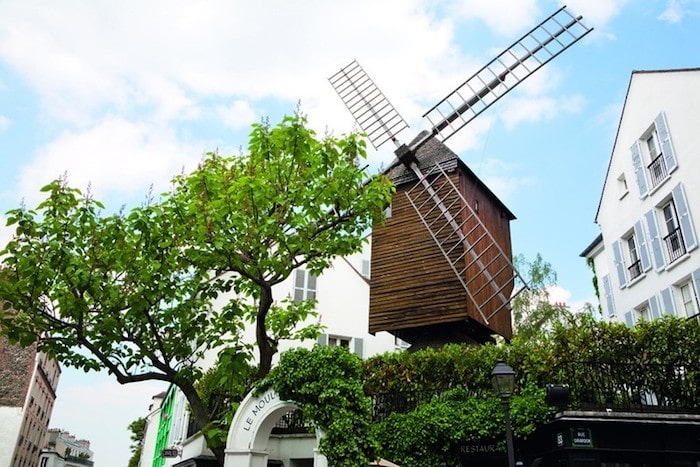
The Moulin Radet, one of the two windmills left in Montmartre. Credit © Paris Tourist Office/Amélie Dupont
Share to: Facebook Twitter LinkedIn Email


